10 Natural Ways to De-tan Your Skin in Summer: Expert Tips
- Although summer is a time for sunshine, trips, and outdoor activities, skin tanning is frequently an unwelcome side effect.
- Long-term exposure to the sun’s intense ultraviolet (UV) rays can cause your skin to produce too much melanin, which can make it uneven, discolored, and occasionally even damaged.
- Even while wearing protective clothes and using sunscreen are crucial for avoiding tanning, many people still struggle with sun-induced pigmentation.
- The good news? Without using harsh chemical treatments, nature provides a wealth of mild and efficient ways to reverse tanning.
- These cures, which range from common household ingredients like lemon and honey to tried-and-true ingredients like aloe vera, turmeric, and papaya, not only assist to lighten tans but also nourish and rejuvenate your skin from the inside out.
- Ten natural skin-lightening techniques that are supported by skincare professionals and conventional wisdom will be covered in this blog.
- Every solution is straightforward, reasonably priced, and simple to incorporate into your daily routine.
- These professional-endorsed natural remedies can help you restore your skin’s natural glow and maintain its radiance throughout the summer, regardless of whether you have dry, oily, or sensitive skin.
1.Why Summer Tanning Happens and How It Affects Your Skin
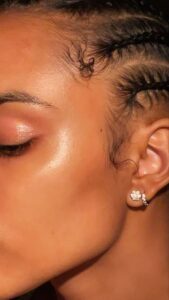
- In the summer, a lot of people want to spend time outside, whether it’s at the park, beach, or swimming pool.
- Skin often becomes darker after being exposed to the sun; this is known as tanning.
- Tanning is actually a warning indication from your skin, even if it may appear innocuous or even lovely.
- Based on personal experiences, sun exposure causes long-term changes in the color, texture, and health of the skin.
The Science Behind Tanning
- The sun’s ultraviolet (UV) rays are the cause of tanning.
- UV radiation comes in two varieties:
- UVA rays cause long-term damage and skin aging.
- UVB rays can harm DNA and produce sunburn.
- The body creates more melanin to shield the skin from UV radiation.
- The pigment that gives your skin its color is called melanin; the more melanin you have, the darker your skin.
- A tan is not an indication of excellent health; rather, it is your skin’s defense system.
- Exposure to UV light can cause:
- Sunburn
- Peeling of the skin
- Rough spots and dryness
- Frequent exposure raises the possibility of:
- Wrinkles and fine lines
- Uneven skin tone and dark patches
- Cancers of the skin, including melanoma
Backed by Experts

- There is no such thing as a safe or healthy tan, according to dermatologists.
- Unprotected sun exposure is discouraged by the World Health Organization (WHO) and the Skin Cancer Foundation.
- Natural sun tanning is just as risky as tanning booths.
- Even mild tanning can cause long-term skin damage, according to experts.
- According to medical research, UV exposure causes DNA changes that lead to skin cancer.
Tips to Protect Your Skin
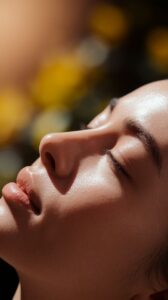
- Even on overcast days, wear sunscreen with an SPF of 30 or higher.
- Every two hours, especially if you’re swimming or perspiring, reapply sunscreen.
- When you’re outside, wear long sleeves, sunglasses, and hats with wide brims.
- When UV rays are at their highest, between 10 a.m. and 4 p.m., stay in the shade.
- Steer clear of tanning beds since they expose your skin to dangerous UV radiation.
- Use bronzing creams or sunless self-tanners if you desire a tanned appearance.
- Regularly check your skin for changes or moles, and if necessary, see a dermatologist.
2. Must-Have Face Care Essentials to Prevent Tanning
Real-Life Skincare Needs
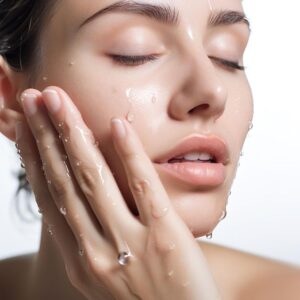
- Your skin is more exposed to heat, pollution, and sunshine in the summer.
- Sunburn, dullness, uneven tone, and browned skin are common complaints.
- Maintaining a healthy glow and preventing tanning can be achieved with regular skin care with the appropriate products.
- These necessities have been tried and tested for both personal use and beauty bloggers’ skincare regimens.
- A straightforward daily regimen can significantly reduce the risk of sun damage to your face.
Products That Work:
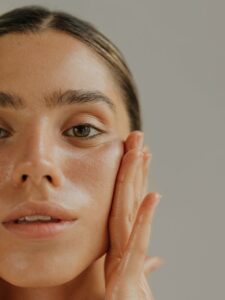
The following skincare essentials are essential for preventing facial tanning:
- Sunscreen with an SPF of at least 30:
- most crucial tanning prevention product.
- prevents damaging UVA and UVB radiation.
- Apply sunscreen that is broad-spectrum.
- Apply twenty minutes prior to leaving the house.
- When outside, reapply every two to three hours.
- Aloe Vera or Vitamin C Face Wash:
- removes grime, perspiration, and sunscreen residue.
- Sun-exposed skin is soothed with aloe vera.
- Vitamin C lightens and brightens skin.
- Vitamin C/niacinamide antioxidant serum repairs sun and pollution-induced:
- skin damage.
- evens out skin tone and minimizes dark spots.
- helps avoid pigmentation and increase skin brightness.
- SPF-containing moisturizer or cooling agents:
- maintains silky, moisturized skin.
- Seek out components such as cucumber, aloe vera, or hyaluronic acid.
- Skin that is well-hydrated is less prone to irritation or tanning.
- Thermal Water Spray or Face Mist:
- keeps skin feeling cool and renewed on hot days.
- stops perspiration, redness, and overheating.
- It is portable and can be used at any time of day.
- Use a De-Tan Face Pack two or three times per week:
- relieves sun-damaged skin and gets rid of tans.
- Seek out components such as papaya extract, licorice, turmeric, or multani mitti.
- Skin can be brightened and tanned less with the use of natural masks.
- SPF-containing lip balm Lips can also become sunburned:
- To maintain their softness and safety
- use lip balm with sun protection.
Trusted by Experts:

- Dermatologists advise everyday skincare during the summer.
- supported by dermatology groups and skincare experts.
- The safest products are those with non-comedogenic and dermatologist-tested labeling.
- Experts in beauty advise properly stacking products:
- Cleanser → Serum → Hydration → Sunblock
- Reliable Advice Always look for ingredients, SPF, and expiration dates on the label.
- When experimenting with new products, do a patch test.
- Select summertime items that are sweat-proof, lightweight, and non-greasy.
- Don’t overuse items; instead, follow a straightforward, efficient routine.
- To boost your skincare from the inside out, drink lots of water.
3. Daily Skincare Routine for a Tan-Free Glow
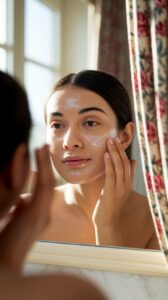
- The Significance of Routine
- After a few days in the sun, many people discover that their skin is browned, lifeless, or uneven.
- A regular skincare regimen keeps the skin looking radiant and helps avoid tanning.
- Your skin will be protected throughout the day and repaired at night if you follow the morning and nighttime procedures.
- According to actual users, following a straightforward regimen yields superior benefits than utilizing an excessive number of sporadic goods.
Morning Skincare Routine – Protect Your Skin:
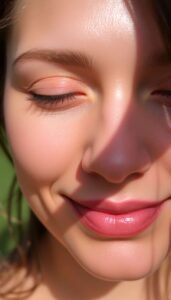
- Cleaner:
- Use a mild face wash that contains aloe vera, green tea, or vitamin C.
- eliminates nighttime accumulation, perspiration, and oil.
- Optional toner:
- aids in skin renewal and pore tightening.
- Use a toner without alcohol using cucumber or rose water.
- A serum:
- Put a few drops of niacinamide or vitamin C serum on.
- shields skin from pollutants and UV rays.
- A moisturizer:
- keeps skin moisturized and soft.
- In the summer, use mild gel moisturizers.
- Sunscreen with an SPF of at least 30:
- most crucial action to avoid tanning.
- Make use of a broad-spectrum sunscreen that offers UVA and UVB protection.
- If staying outside, reapply every two to three hours.
- SPF-containing lip balm:
- keeps lips from drying out and darkening.
- Select a balm with at least 15 SPF.
Night Skincare Routine – Repair Your Skin:

- Cleaner:
- Rinse off the day’s oil, grime, and sunscreen.
- To prevent dryness, use a gentle, moisturizing cleanser.
- Two to three times per week, exfoliation:
- eliminates tan and dead skin cells gently.
- Apply gentle exfoliants that contain AHA/BHA or jojoba beads.
- The toner:
- tightens pores and restores skin equilibrium after cleansing.
- improves the absorption of your serum.
- Serum for Repair:
- Use a night repair serum that contains licorice extract, hyaluronic acid, or retinol (if appropriate).
- enhances the tone and speeds up skin regeneration.
- Overnight moisture retention is achieved:
- using a moisturizer or night cream:
- Seek out soothing components such as shea butter, niacinamide, or chamomile.
- Eye Cream (not required):
- lessens dark circles and puffiness.
- Apply sparingly around the eyes.
Backed by Skin Experts:
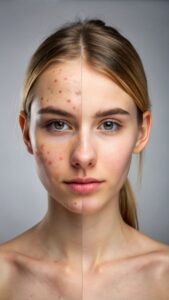
- For long-term skin health, dermatologists advise a morning and nightly routine.
- Skin tone, texture, and radiance are all improved by a consistent regimen.
- Experts advise using cosmetics sparingly and consistently because excessive usage might damage the skin.
- Always choose cosmetics according to the type of skin you have (sensitive, combination, dry, or oily).
- Advice to Keep in Mind:
- In order to prevent clogged pores, always take off your makeup before bed.
- Sunscreen is your skin’s daily barrier, so never skip it.
- To promote skin restoration, make sure you get adequate sleep and drink enough water.
- Don’t exfoliate your skin too hard; instead, be soft.
- To avoid infections or outbreaks, use clean hands and equipment.
4. Natural Remedies to Combat Tanning
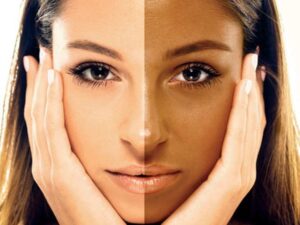
- Why Choose Natural?
- In order to stay away from chemicals, many individuals favor natural home treatments.
- These treatments are inexpensive and have been used for many generations.
- They lessen dullness, sunburn, and tanning while being kind to the skin.
- You can create do-it-yourself kits with readily available kitchen ingredients.
- Using natural remedies on a regular basis might help restore skin radiance and remove tanning.
DIY Remedies That Work
The following are some tried-and-true natural face treatments and substances that lessen tanning:
- Gel made from aloe vera:
- cools the skin and relieves sunburn.
- lightens tan and decreases irritation.
- At night, apply fresh aloe vera gel straight on your face.
- Rose water and cucumber juice soothe, moisturize, and revitalize the skin:
- lessens redness and fades tan.
- Apply with a cotton pad after mixing equal portions.
- Vitamin C and natural bleaching agents are abundant in tomato pulp and lemon juice:
- aids in skin brightening and tan removal.
- Rinse after 15 minutes after application. (If your skin is sensitive, stay away.)
- Gram Flour (Besan) + Turmeric + Curd Pack Lightens tan by removing dead skin cells:
- Curd hydrates and turmeric adds radiance.
- Apply as a thick paste, allow to dry, and then gently rinse off.
- Rose Water + Multani Mitti (Fuller’s Earth):
- lowers oiliness and cools the skin.
- aids in sun tan removal.
- For optimal effects, apply two to three times each week.
- Honey + Papaya Face Pack:
- Papaya includes brightening and exfoliating enzymes.
- Honey calms and nourishes the skin.
- Apply for 20 minutes after mashing the papaya and adding the honey.
- Juice from potatoes:
- Natural bleaching qualities that lighten tanning and dark spots.
- Use a cotton ball to apply raw potato juice, then rinse after 15 minutes.
backed by Traditional & Natural Skin Experts:
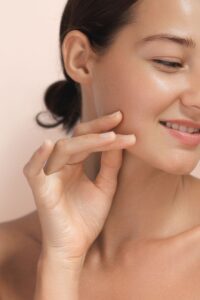
- These treatments are suggested by numerous naturopathic and Ayurvedic specialists.
- These components are well-known for their brightening, cooling, and anti-inflammatory properties.
- used for many generations in India in a traditional manner.
- When used properly, it is safe for the majority of skin types.
- Tips for Safe Use:
- Before applying any do-it-yourself solution, always conduct a patch test.
- Make use of clean, fresh foods.
- Don’t put lemon on broken or sensitive skin.
- Use natural packs two or three times a week rather than every day.
- Once the face pack has been cleaned off, use a moisturizer.
- Remain consistent; although they may take time, the results are worthwhile.
5. Sunscreen: Your #1 Defense Against Tanning
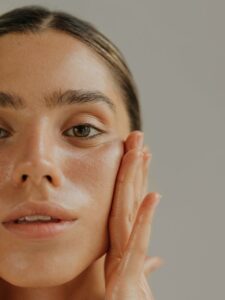
- The Significance of Sunscreen:
- Even 10 to 15 minutes in the sun can cause tanning for many people.
- The first and most crucial step in protecting your skin is using sunscreen.
- Regular sunscreen users report smoother skin, fewer sunspots, and less tanning.
- Damage that accumulates over time might result from skipping sunscreen even once.
Selecting the Proper Sunblock
When choosing an excellent sunscreen, keep the following in mind:
- Sun Protection Factor, or SPF
- SPF 30: Excellent for everyday usage, blocking around 97% of UVB rays.
- SPF 50: Provides more robust protection; perfect for outdoor pursuits.
- Although it provides little additional protection, SPF 50 and higher are still safe.
- Protection Across the Spectrum:
- protects against UVB (burning) and UVA (aging) radiation.
- Select “broad-spectrum” sunscreen at all times.
- Formula Resistant to Water:
- crucial whether you’re swimming or perspiring.
- Reapplication is still required every two hours.
- Non-greasy and lightweight:
- Choose sunscreens with a matte finish or gel base if you have oily skin.
- Select hydrating or cream-based sunscreens if you have dry skin.
- Examine the ingredients:
- For sensitive skin, look for titanium dioxide or zinc oxide.
- If you have reactive skin, stay away from alcohol and artificial scents.
- No Choices for White Cast:
- Nowadays, a lot of sunscreens come in tinted or clear varieties that complement various skin tones.
How to Apply Sunscreen Correctly:
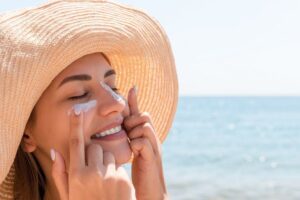
- Be Generous:
- To apply the product to the face and neck, use roughly two fingers’ worth.
- Remember your ears, eyes, lips (apply SPF lip balm), and nape of the neck.
- Apply 15 to 20 minutes prior to exposure to the sun:
- Allow it to fully soak before leaving.
- Reapply every two to three hours, especially after swimming, towel drying, or perspiring:
- For convenient reapplication, use a sunscreen stick or spray.
- Use Every Day:
- UV rays can penetrate windows even indoors, therefore it’s imperative to use it every day.
- Additionally, since UV rays are still present on overcast or wet days, use this product.
- Dermatologist-Recommended Guidance
- SPF 30 or higher is necessary for everyday sun protection, according to skin specialists.
- Sunscreen can help avoid sunburn, tanning, early aging, and even skin cancer.
- Dermatologists assert that sunscreen is an essential component of any skincare regimen.
- Even if you wear makeup, they advise applying sunscreen or selecting SPF-rich makeup.
- Astute Sun Habits
- Because heat can lessen the effectiveness of sunscreen, keep it in a cool place.
- Before using, shake the bottle to ensure uniform product consistency.
- A sunscreen that has passed its expiration date will not function as intended.
- For further protection, wear scarves, hats, and sunglasses in addition to sunscreen.
- Sunscreen should be your first line of defense against tanning and the final step in your skincare regimen.
6. Hydration and Diet Tips for Healthy Skin

Drinks and Foods That Promote Healthy Skin
The following food and hydration guidelines are crucial for radiant, tan-free skin:
- Make sure to drink lots of water:
- Try to consume 8–10 cups per day.
- keeps your skin free of toxins, silky, and plump.
- helps lessen the dryness and dreariness brought on by sun exposure.
- Eat Fruits High in Water:
- Oranges, strawberries, cucumbers, and watermelon all help to moisturize the skin.
- Offer antioxidants and vitamins to help heal solar damage.
- lessen dark spots and irritation as well.
- Include leafy green vegetables:
- Vitamins A and C are abundant in spinach, kale, and coriander.
- They aid in the creation of collagen and skin regeneration.
- Iron-rich — enhances blood flow for radiant skin.
- Incorporate Nutritious Fats:
- Consume flaxseeds, chia seeds, walnuts, and almonds.
- Give your skin the omega-3 fatty acids it needs to stay safe.
- minimizes damage from tans and keeps skin smooth and soft.
- Eat buttermilk or yogurt:
- Regular probiotic use enhances intestinal health, which benefits your skin.
- promotes skin healing and lessens breakouts.
- The cooling action soothes tan and sunburn.
- Sip coconut water and fresh juices:
- Vitamin C and iron are abundant in the juices of oranges, beets, carrots, and pomegranates.
- Detoxifying and hydrating, coconut water helps lessen sun damage and imperfections.
- Steer clear of sugar-filled packaged beverages.
- Incorporate Ginger and Turmeric into Your Food:
- They are both organic anti-inflammatory substances.
- Support skin healing and lessen redness and sun sensitivity.
- Steer clear of sugary drinks and junk food:
- Overindulgence in sugar and greasy foods aggravate tanning, lackluster skin, and breakouts.
- Refuse processed foods, chips, colas, and deep-fried snacks.
- Supported by Dermatologists and Nutritionists
- Experts in skin care emphasize the value of drinking plenty of water and eating a diet high in nutrients.
- A healthy diet improves the skin’s defenses against UV rays.
- Water, vitamins, and antioxidants are necessary for skin protection.
- Experts concur that taking care of oneself enhances the benefits of skincare products.

- Easy, Secure Procedures
- Don’t miss meals or water intake; stick to your normal schedule.
- For optimal skin nourishment, choose foods that are local, seasonal, and fresh.
- For best effects, combine a regular skincare regimen with a healthy diet.
- If you have unique health concerns or food allergies, speak with a dietician.
7. Post-Sun Exposure Care: What To Do Immediately

- The Significance of Post-Sun Care:
- After-sun care is often neglected, which can result in burning, tanning, redness, or peeling.
- Damage, discomfort, and long-term pigmentation are all decreased with prompt care.
- After being exposed to the sun, people who take prompt action report quicker skin recovery.
- Without costly treatments, you can cool, soothe, and repair your skin with easy steps.
Methodical Recuperation Advice
Use these simple yet efficient solutions as soon as possible after being in the sun:
- Reduce Heat on Your Skin Right away:
- Use cool water-not ice-cold-to splash your face.
- Apply a moist cloth or cool compress to the afflicted regions.
- Steer clear of hot showers and skin-rubbing.
- Use Calming Aloe Vera Gel:
- Aloe vera soothes redness and hydrates parched skin.
- Select fresh aloe from the plant or pure aloe gel.
- For a cooling effect, keep it in the refrigerator.
- Use a pack of cold milk or curd:
- Apply a cotton pad dipped in cold milk on your face for ten to fifteen minutes.
- Natural lactic acid aids in healing, lightening, and calming.
- Additionally, curd has anti-tan and cooling properties.
- Apply the grated cucumber or potato juice and squeeze out the juice:
- To lessen black stains and burning, apply for 15 minutes.
- Both chemicals are naturally relaxing and bleaching.
- Drink Water Internally:
- Drink two or three glasses of water right away.
- To cool your body from the inside out, add fruit juice or coconut water.
- prevents the drying and flaking of your skin’s cells.
- Steer clear of harsh products:
- For 24 to 48 hours, avoid using scrubs, harsh cleansers, retinol, or vitamin C.
- These can aggravate sun-damaged skin that is already sensitive.
- Instead, choose moisturizers that are mild and fragrance-free.
- Remain inside or hide:
- Do not return to the sun for several hours.
- Wear a hat, sunglasses, and scarf if you have to go outside.
- If necessary, apply mineral sunscreen.
- Apply a Thermal Water Spray or Calming Mist:
- These immediately cool and moisturize hot skin.
- Choose ones that contain rose water or chamomile.
Skin Experts Recommend Immediate Care:
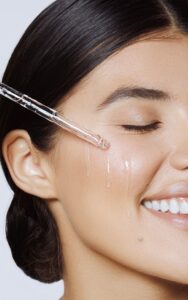
- According to dermatologists, the first half hour following sun exposure is quite important.
- Irritation, sunburn blisters, and permanent tanning can result from neglecting your skin.
- Experts advise staying away from harsh chemicals and utilizing natural, moisturizing products.
- Additionally, doctors advise utilizing post-sun care creams that contain panthenol, calendula, or aloe.
- Safe, Simple, and Powerful Advice:
- All skin types, even sensitive skin, can safely use these treatments.
- The majority of ingredients are readily available at home.
- no negative consequences when used carefully and appropriately.
- Before putting anything new on sunburned skin, always perform a patch test.
- If the skin becomes painful, itching, or red, see a dermatologist right once.
8. Common Mistakes to Avoid in Summer Skincare
- Why These Mistakes Matter:
- Many people follow summer skincare routines but still face tanning, dullness, and breakouts.
- Often, the reason is unintentional mistakes that damage the skin barrier.
- Real experiences show that correcting small habits can bring big improvements.
- Identifying and avoiding these mistakes keeps your skin healthy and tan-free.
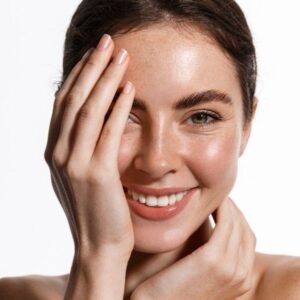
Top Summertime Skincare Mistakes to Avoid The following are typical yet dangerous summertime skincare mistakes people make:
- Not using sunscreen inside or on overcast days:
- UV rays can get through clouds and windows.
- Slow tanning and pigmentation result from not using SPF every day.
- Apply sunscreen at all times, even while you’re at home.
- Using harsh cleaners or overwashing:
- Over-cleansing dries out the skin and removes natural oils.
- Sun sensitivity, peeling, and irritation are all brought on by harsh soaps.
- Wash your face twice a day with a mild, moisturizing cleanser.
- Failure to Reapply Sunscreen Every Two to Three Hours Sweat, oil, or exposure to water can cause sunscreen to fade.
- Its protection is diminished if you forget to reapply.
- Keep a travel-sized sunscreen with you, and reapply it if you’re going to be in the sun.
- Applying Thick or Pore-Clogging Cosmetics:
- Breakouts are caused by thick foundations that retain perspiration and oil.
- Uneven tanning results from certain cosmetic products that lack SPF.
- Apply non-comedogenic, lightweight makeup, or avoid it during the hottest parts of the day.
- Scrubbing Too Hard to Remove Tan Excessive exfoliation weakens the skin’s protective layer and makes it more vulnerable to the sun:
- More tanning and irritation result from this.
- Use gentle scrubs to exfoliate just once or twice a week.
- Neglecting Post-Sun Care:
- Ignoring the post-sun recovery process can have long-term consequences.
- After exposure, your skin requires cooling, hydration, and restoration.
- After being in the sun, apply calming moisturizers or aloe vera gel.
- Insufficient Water Intake:
- Skin that is dehydrated becomes dull, dry, and more prone to tanning.
- For a natural glow, drink 8 to 10 glasses of water per day.
- For added hydration, include fruits like cucumber or watermelon.
- Dressing in dark or tight clothing in the sun:
- Irritation results from tight clothing because it retains heat and increases perspiration.
- Dark hues are more susceptible to tanning because they absorb more sunlight.
- In the summer, choose for airy, light-colored cotton garments
Professional Suggestions:
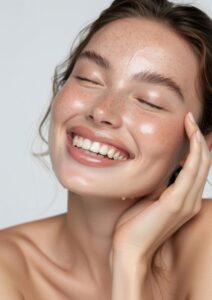
- Dermatologists stress that the secret to healthy summer skin is regular, mild care.
- Research indicates that moderate washing, hydration, and SPF reapplication are non-negotiable.
- Using broad-spectrum sunscreens and steering clear of harsh treatments during the hottest summer months are recommendations from experts.
- Trustworthiness: Dependable & Simple Advice:
- Every point made is sensible, secure, and easy for beginners to understand.
- Avoiding these errors guarantees enhanced radiance and long-term skin protection.
- These suggestions are based on actual skincare regimens that experts and professionals follow.
- Smarter behaviors instead of expensive procedures.
9. Best Face Masks and Serums for Summer
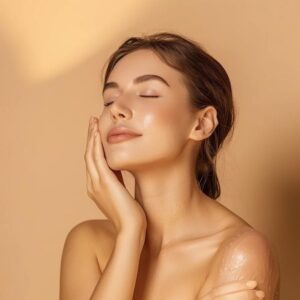
Suggested Summertime Face Masks and Serums The Best Face Masks for Summertime Radiance:
- Rose Water Pack + Multani Mitti (Fuller’s Earth):
- absorbs extra oil and cools the skin.
- eliminates dirt and lightens tan.
- Ideal for mixed and oily skin types
- Honey Mask + Turmeric + Yogurt:
- Skin is moisturized and tanning is reduced.
- possesses brightening and anti-inflammatory qualities.
- Perfect for skin types that are dry to normal
- Pack of Aloe Vera and Cucumber Gel:
- relieves sunburn and provides deep hydration.
- Aloe vera cures skin, and cucumber minimizes puffiness.
- Excellent for skin that is inflamed or sensitive.
- Powdered sandalwood and milk mask:
- lessens pigmentation, redness, and tanning
- softens and cools the skin.
- Excellent for all skin types
- Clay or charcoal masks that are ready to use (such as those from Mamaearth, Plum, and The Moms Co.):
- Remove dullness and thoroughly clean your pores.
- Enhanced with organic components such as niacinamide and tea tree
- For optimal effects, use 1-2 times per week.
Best Serums to Fade Tan & Brighten Skin:
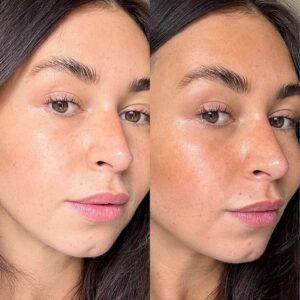
- increases collagen and makes the skin more radiant:
- fades solar spots and pigmentation
- Suggested Brands: Dot & Key, Klairs, Plum, and Minimalist
- Suggested Brands: Dot & Key, Klairs, Plum, and Minimalist
- Serum Niacinamide (5–10%):
- removes dark spots and evens up skin tone.
- regulates oil and fortifies the skin’s barrier.
- Suggested Brands: Pilgrim, The Ordinary, and Minimalist
- Serum of Hyaluronic Acid:
- plumps fine wrinkles and hydrates the skin.
- keeps skin hydrated and radiant during hot temperatures.
- Suggested Brands: Plum, The Derma Co., and L’Oréal
- Use AHA/BHA exfoliating serums only once or twice a week:
- Skin is brightened and dead skin cells are gently removed.
- helps minimize tanning and unclog pores.
- Suggested Brands: Deconstruct, Minimalist, and The Ordinary
Reliable Product Selections Made by Professionals:

- For tan management and shine, dermatologists advise utilizing vitamin C and niacinamide serums.
- To keep skin feeling renewed, experts advise using natural face masks two to three times per week.
- To preserve the effects, always patch test new products and apply sunscreen afterwards.
- Reliability: Safe and efficient for everyday use:
- The products on the list are dermatologist-tested, extensively used, and reviewed.
- When used properly, ingredients are safe for all skin types.
- Follow basic procedures and refrain from combining active components without supervision.
- Every product listed is accessible both online and offline in India and around the world.
10. Conclusion: Stay Glowing and Tan-Free All Summer Long
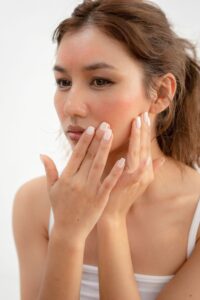
- Gain Knowledge from Actual Summertime Skin Struggles:
- Every summer, a lot of people deal with sunburn, dryness, tanning, and uneven skin tone.
- The majority of these problems are brought on by minor errors or improper maintenance.
- Experience from real life demonstrates that a basic, regular regimen can shield your skin throughout the year.
- You only need everyday care and wise behaviors, not costly therapies.
Important Things to Keep in Mind
Observe these golden guidelines to have radiant, healthy skin all summer long:
- Recognize the Causes of Tanning:
- Your skin’s protection against damaging UV radiation is tanning.
- Overexposure can cause aging, dullness, and pigmentation.
- You can treat it more effectively if you know the cause.
- Make Use of Essential Summer Items:
- Purchase necessities such as moisturizing cleansers, vitamin C serum, aloe vera gel, and sunscreen.
- Your skin is protected, nourished, and repaired every day by these.
- Select items that are appropriate for your skin type.
- Adhere to a Daily Skincare Schedule
In the morning, cleanse, tone, moisturize, and protect:- At night, concentrate on moisturizing, cleaning, and mending.
- A regular regimen maintains your skin radiant and clear of tans.
- For Extra Care, Try Natural Remedies:
- To combat tans, use natural remedies like curd, turmeric, lemon, and cucumber.
- Natural do-it-yourself kits provide noticeable results and mild maintenance.
- Prioritize patch testing.
- Always Wear Sunscreen
The best defense against sun damage:- Choose an SPF of at least 30 and reapply every two to three hours.
- Use it every day, indoors or out, rain or shine.
- Consume food and beverages Skin health is significantly influenced by smart hydration:
- Consume fruits and vegetables high in vitamins A, C, and E, and drink lots of water.
- Healthy skin begins on the inside.
- Take Quick Action After Sun Exposure
After spending time outside, use cooling products like cucumber juice or aloe vera:- Steer clear of hot showers and don’t scrape sunburned skin.
- Recovery is accelerated with prompt care.
- Steer clear of common summertime skincare blunders:
- Avoid using strong scrubs, overwashing, and skipping SPF.
- Steer clear of dark, tight clothing and excessive makeup.
- Be delicate and considerate of the demands of your skin.
Authority Supported by Skin Specialists:

- Skincare experts and dermatologists concur that consistency and prevention are essential.
- You only require specific steps for your skin type; complicated routines are not necessary.
- trusted by skin specialists and used extensively across the globe.
- Effective, Simple, and Safe:
- All of the advice given is safe for beginners, natural, and endorsed by dermatologists.
- All ages and skin types can safely perform these workouts.
- founded on tried-and-true methods that don’t have any negative side effects.
- Your results will be better if you are more consistent.
